The consequences of the dramatic events that followed the Arab Spring protests will continue to impact Middle Eastern and North African politics for many years to come.
The overthrow of the governments in Yemen and Egypt, the longstanding civil war in Syria and the tragic events associated with it all had their roots in the initially peaceful protests that began in these countries in 2011. The protests resulted in nearly 6,000 deaths, tens of thousands of injuries, and left three countries in varying states of instability or outright civil war.
Check out Sputnik's gallery to recall the events that have forever changed the landscape of this turbulent region.
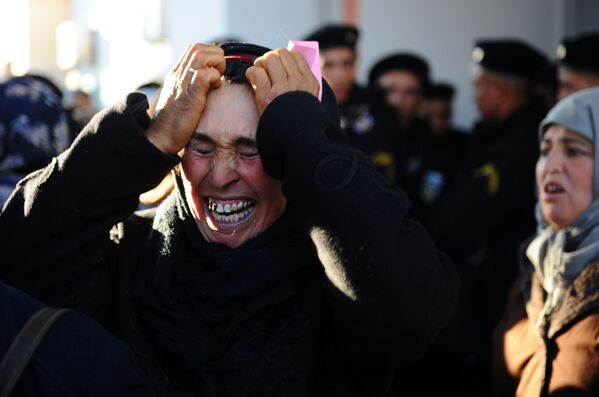
The first protests began in Tunisia in December 2010 after local street vendor Mohamed Bouazizi set himself on fire in opposition to what his supporters described as harassment by authorities and municipal government corruption. He died in hospital several weeks after.
Above: A woman cries in front of a prefecture as she waits with other people to meet the governor on 10 January 2011 in Sidi Bouzid. Tunisian President Zine El Abidine Ben Ali described the weekend rioting as "terrorist acts" and blamed "gangs of thugs" for the explosion of violence that left at least 14 people dead.
Above: A woman cries in front of a prefecture as she waits with other people to meet the governor on 10 January 2011 in Sidi Bouzid. Tunisian President Zine El Abidine Ben Ali described the weekend rioting as "terrorist acts" and blamed "gangs of thugs" for the explosion of violence that left at least 14 people dead.
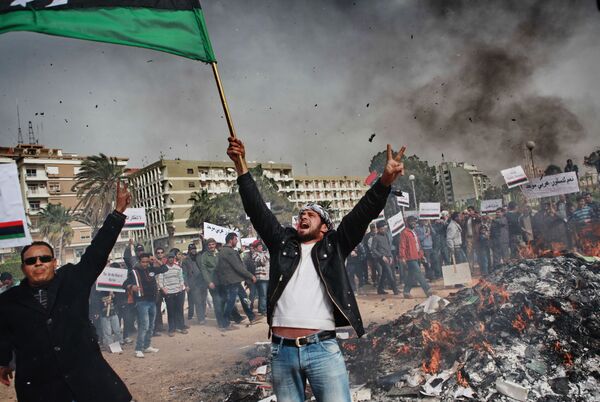
The Libyan Civil War that followed the unrest in the county was fought between Muammar Gaddafi’s supporters and forces seeking to oust his government. It prompted a NATO-led military intervention in Libya in 2011.
Above: Residents of Benghazi burn portraits of Muammar Gaddafi, posters with his quotes, and his "Green Book".
Above: Residents of Benghazi burn portraits of Muammar Gaddafi, posters with his quotes, and his "Green Book".
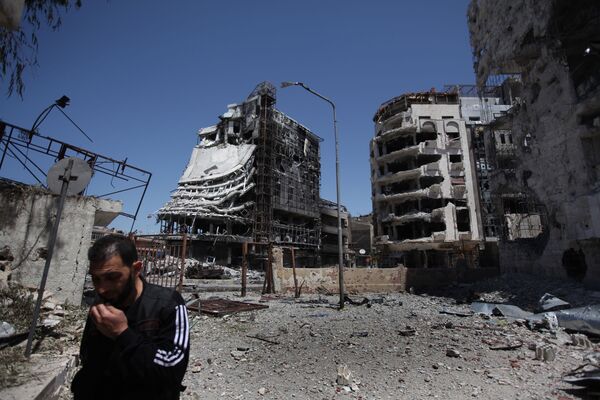
In Syria, the unrest prompted the formation of the Free Syrian Army with the goal of bringing down the government of President Bashar al-Assad.
Above: Syria's al-Khalidiya neighbourhood in the city of Homs under the control of Syrian Free Army opposition forces.
Above: Syria's al-Khalidiya neighbourhood in the city of Homs under the control of Syrian Free Army opposition forces.
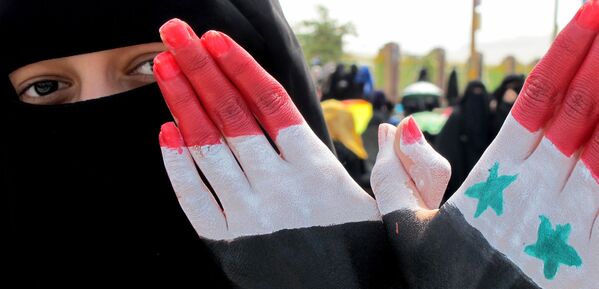
In Yemen, protests led to two governments being overthrown - in February 2012 and in January 2015.
Above: In this file photo taken on 4 November 2011, a Yemeni woman holds up her hands painted in the colours of the Yemeni flag (L) and the Syrian flag during a mass protest against the rule of President Ali Abdullah Saleh in the country's capital Sanaa.
Above: In this file photo taken on 4 November 2011, a Yemeni woman holds up her hands painted in the colours of the Yemeni flag (L) and the Syrian flag during a mass protest against the rule of President Ali Abdullah Saleh in the country's capital Sanaa.
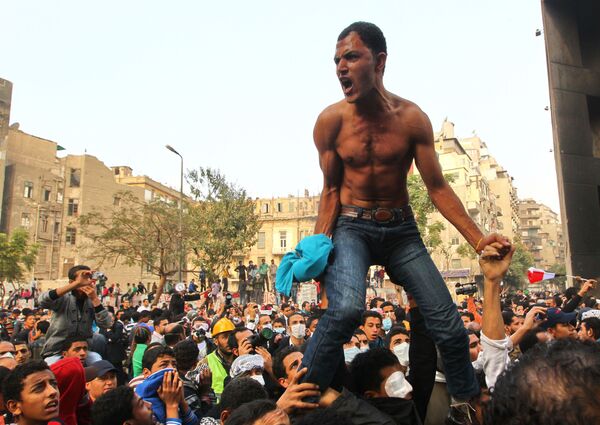
In 2012, Egypt's President Hosni Mubarak was sentenced to life imprisonment for failing to stop the killing of peaceful protesters during unrest in the country. He was acquitted five years later.
Above: Participants of the riots in the Egyptian capital.
Above: Participants of the riots in the Egyptian capital.
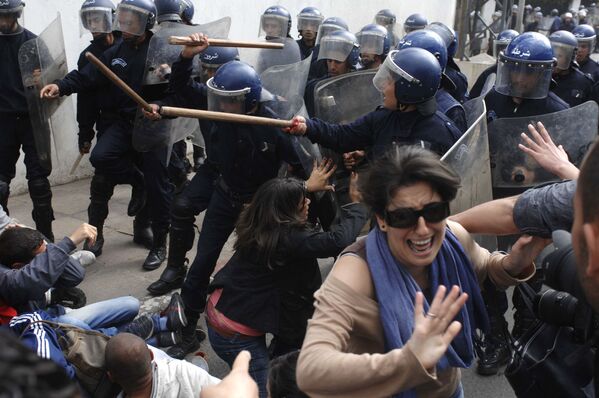
6/24
© AP Photo / Anis Belghoul
Major protests erupted in Algeria in December 2010, with demonstrators often citing unemployment, high inflation, and corruption as reasons for their unrest.
Above: Students react during clashes with police officers in Algiers, Tuesday 12 April 2011. Thousands of students were marching in Algeria's capital to demand the resignation of the education minister in the latest anti-government protests to sweep across the Arab world.
Above: Students react during clashes with police officers in Algiers, Tuesday 12 April 2011. Thousands of students were marching in Algeria's capital to demand the resignation of the education minister in the latest anti-government protests to sweep across the Arab world.

The government of Libya's leader Muammar Gaddafi was overthrown in February 2011. The politician was killed several months later near his hometown of Sirte, allegedly by rebel forces.
Above: Portrait of Muammar Gaddafi on fire.
Above: Portrait of Muammar Gaddafi on fire.
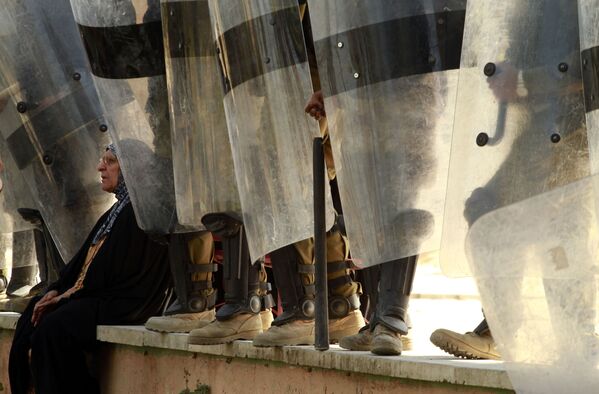
8/24
© AP Photo / Maya Alleruzzo
To avoid major confrontations like those that swept neighbouring countries, Iraqi Prime Minister Nouri al-Maliki's office announced that the politician would limit his rule to only two terms in the name of democracy.
Above: An Iraqi woman rests at the feet of riot police during a demonstration in Tahrir Square in central Baghdad, Iraq, Friday, 18 March 2011.
Above: An Iraqi woman rests at the feet of riot police during a demonstration in Tahrir Square in central Baghdad, Iraq, Friday, 18 March 2011.
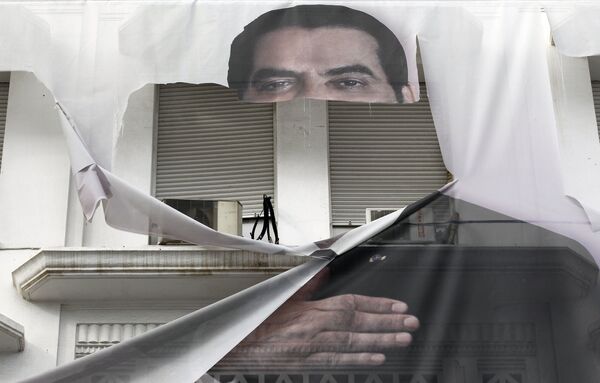
9/24
© AP Photo / Christophe Ena
Tunisian President Zine El Abidine Ben Ali declared a state of emergency in the country on 14 January 2011 following major unrest inspired by Mohamed Bouazizi's death. Ben Ali fled the country to Malta on the same day.
Above: A torn banner of former Tunisian President Zine El Abidine Ben Ali is seen in the centre of Tunis, Sunday, 16 January 2011.
Above: A torn banner of former Tunisian President Zine El Abidine Ben Ali is seen in the centre of Tunis, Sunday, 16 January 2011.
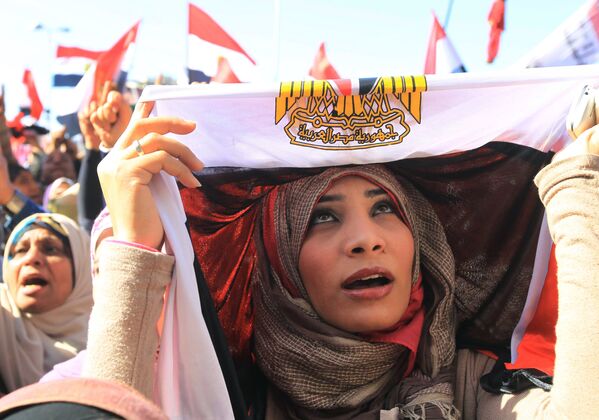
Egypt heard calls from demonstrators complaining about crippled freedom of speech, widespread corruption, police brutality, soaring inflation, and high unemployment.
Above: An Egyptian woman covers her head in a national flag as she demonstrates in Cairo's Tahrir Square on 27 January 2012, ahead of a mass rally to demand democratic change, a year after the country's revolt that overthrew the regime.
Above: An Egyptian woman covers her head in a national flag as she demonstrates in Cairo's Tahrir Square on 27 January 2012, ahead of a mass rally to demand democratic change, a year after the country's revolt that overthrew the regime.
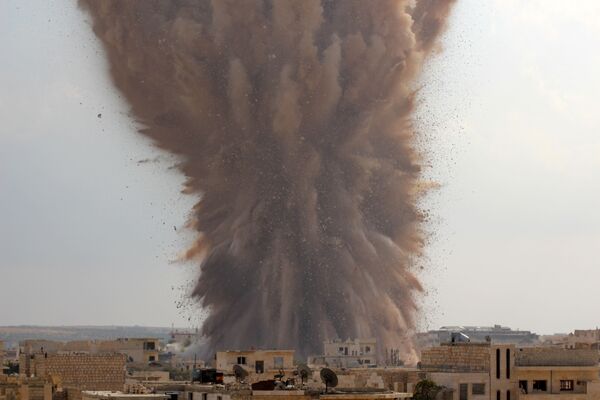
Syrian President Bashar al-Assad was accused by opposition forces and Western governments of using chemical weapons during the Syrian Civil War that followed the unrest in the country. These claims were rejected by his government, which insisted that it had destroyed all of the chemical weapons stockpiles under its control under the observation of the Organisation for the Prohibition of Chemical Weapons back in 2013. However, this didn't stop the US, the UK, and France from conducting "retaliatory" strikes against Syrian government forces over poorly substantiated reports of the use of chemical weapons against rebels in 2018.
Above: A picture taken on 14 October 2014 shows a large explosion allegedly hitting a Syrian Army military outpost in the southern part of the city of Maaret al-Numan in Idlib province. The explosion was reportedly caused by rebel fighters belonging to the Ahrar al-Sham Brigade of the Islamic Front coalition, who dug a tunnel underneath the outpost and filled it with explosives.
Above: A picture taken on 14 October 2014 shows a large explosion allegedly hitting a Syrian Army military outpost in the southern part of the city of Maaret al-Numan in Idlib province. The explosion was reportedly caused by rebel fighters belonging to the Ahrar al-Sham Brigade of the Islamic Front coalition, who dug a tunnel underneath the outpost and filled it with explosives.
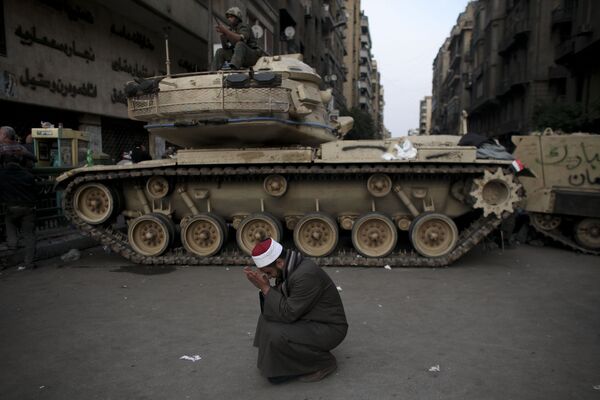
12/24
© AP Photo / Tara Todras-Whitehill
Egyptian President Hosni Mubarak stepped down from his post on 11 February 2011 following several weeks of demonstrations, passing his powers to the Supreme Council of the Armed Forces, which subsequently led the transition process.
Above: An Egyptian Muslim cleric cries in front of an army tank in Tahrir, or Liberation Square, in Cairo, Egypt, Wednesday, 2 February 2011. Several thousand supporters of President Hosni Mubarak, including some riding horses and camels and wielding whips, clashed with anti-government protesters.
Above: An Egyptian Muslim cleric cries in front of an army tank in Tahrir, or Liberation Square, in Cairo, Egypt, Wednesday, 2 February 2011. Several thousand supporters of President Hosni Mubarak, including some riding horses and camels and wielding whips, clashed with anti-government protesters.
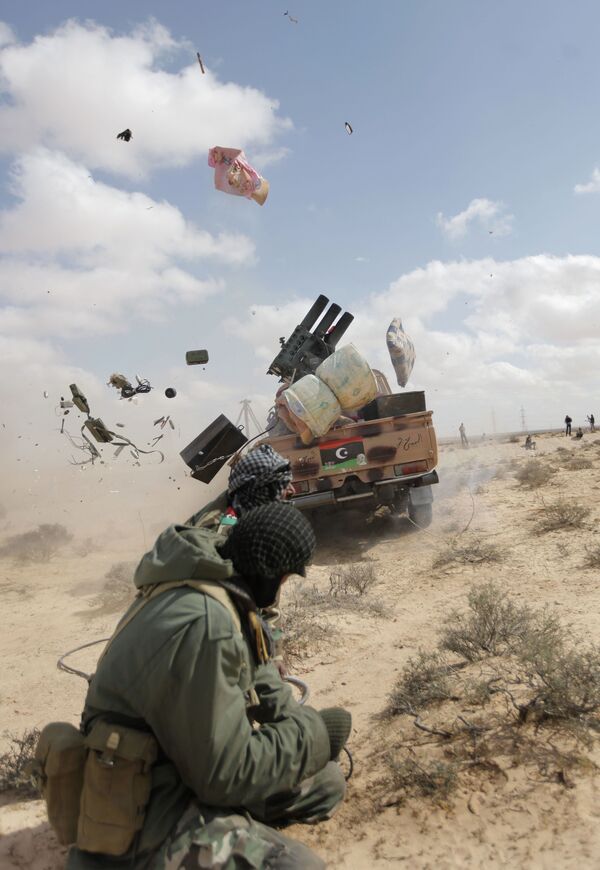
13/24
© AP Photo / Nasser Nasser
Muammar Gaddafi's murder on 20 October 2011 did not ultimately bring peace to the country as the political disagreements between the emerging factions in the uprising led to the start of a new civil war in 2014.
Above: A Libyan rebel rocket launcher misfires while shelling pro-Gaddafi forces along the front line outside the eastern town of Brega, Libya Thursday, 31 March 2011.
Above: A Libyan rebel rocket launcher misfires while shelling pro-Gaddafi forces along the front line outside the eastern town of Brega, Libya Thursday, 31 March 2011.
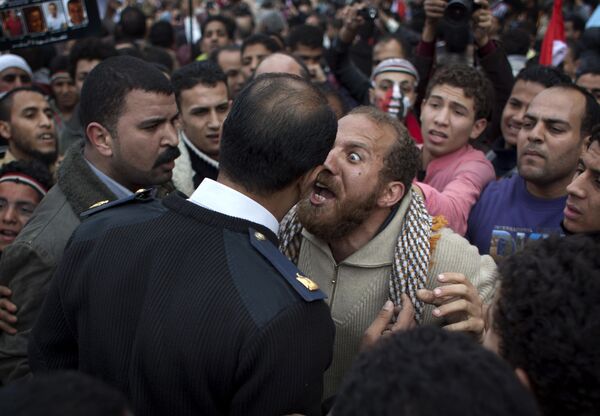
14/24
© AP Photo / Emilio Morenatti
The two-week-long protests in Cairo and other Egyptian cities did not go without bloodshed, with some 846 people killed and over 6,400 injured in the process, largely due to the actions of the police.
Above: An Egyptian protester, centre right, argues with a police officer in Tahrir Square in downtown Cairo, Egypt, Sunday, 13 February 2011.
Above: An Egyptian protester, centre right, argues with a police officer in Tahrir Square in downtown Cairo, Egypt, Sunday, 13 February 2011.
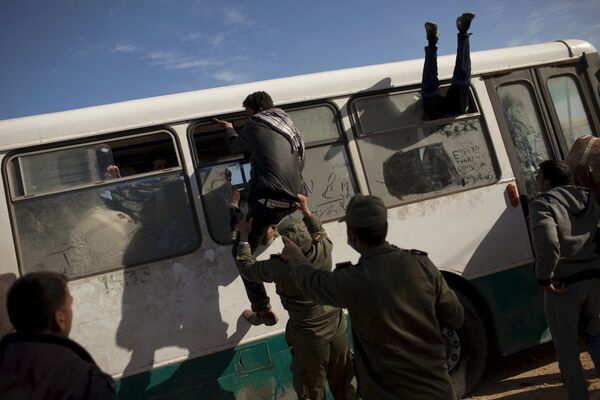
15/24
© AP Photo / Emilio Morenatti
The emergence of unrest in Tunisia preceded the start of the protests in Egypt, with the first Tahrir Square demonstrations starting roughly two weeks after the self-immolation of Mohamed Bouazizi in the city of Ben Arous.
Above: Egyptians try to board a bus as a Tunisian Army soldier tries to stop one of them, at the Tunisia-Libya border, in Ras Ajdir, Tunisia, Thursday, 3 March 2011.
Above: Egyptians try to board a bus as a Tunisian Army soldier tries to stop one of them, at the Tunisia-Libya border, in Ras Ajdir, Tunisia, Thursday, 3 March 2011.
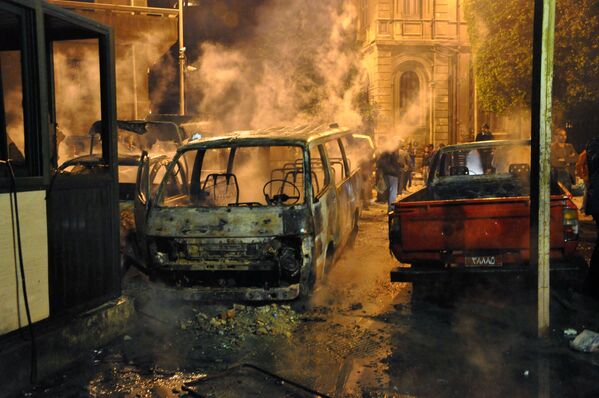
16/24
© AP Photo / Ahmed Mohammed
While many protests during Egypt’s 2011 revolution were peaceful, some demonstrators used the ensuing chaos as cover to go on a looting spree. In some cities, other protesters organised groups of vigilantes to deal with the looting.
Above: In this Friday, 4 March 2011 photo, state security cars smoulder after they were set on fire by protesters outside the police security headquarters in Alexandria, Egypt.
Above: In this Friday, 4 March 2011 photo, state security cars smoulder after they were set on fire by protesters outside the police security headquarters in Alexandria, Egypt.
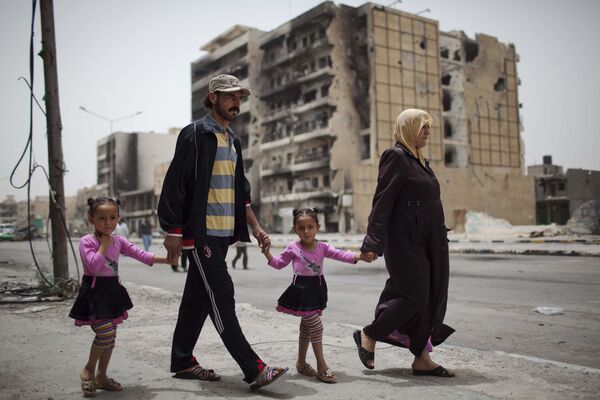
17/24
© AP Photo / Rodrigo Abd
Nine years since the start of the uprising and the death of Muammar Gaddafi, Libya is still ravaged by the internal conflict involving the UN-recognised Government of National Accord (GNA) on the one side, and the Libyan House of Representatives and the Libyan National Army (LNA) supporting it, on the other.
Above: A family walks in Tripoli Street, the centre of the fighting between the rebels and Muammar Gaddafi’s forces in Misrata, Libya, Sunday, 22 May 2011.
Above: A family walks in Tripoli Street, the centre of the fighting between the rebels and Muammar Gaddafi’s forces in Misrata, Libya, Sunday, 22 May 2011.
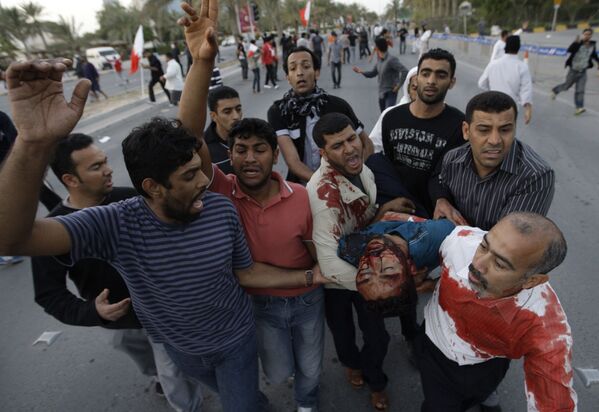
18/24
© AP Photo
The Arab Spring protests also affected the Kingdom of Bahrain, where demonstrators first demanded broader political freedoms, but after a brutal raid on the demonstrators' camp at the Pearl Roundabout in Manama, they also called for ending the rule of King Hamad bin Isa bin Salman Al Khalifa.
Above: WARNING! GRAPHIC CONTENT! An unidentified Bahraini anti-government protester is carried to a vehicle to be taken to hospital after being wounded during a demonstration in Manama, Bahrain, Friday, 18 February 2011.
Above: WARNING! GRAPHIC CONTENT! An unidentified Bahraini anti-government protester is carried to a vehicle to be taken to hospital after being wounded during a demonstration in Manama, Bahrain, Friday, 18 February 2011.
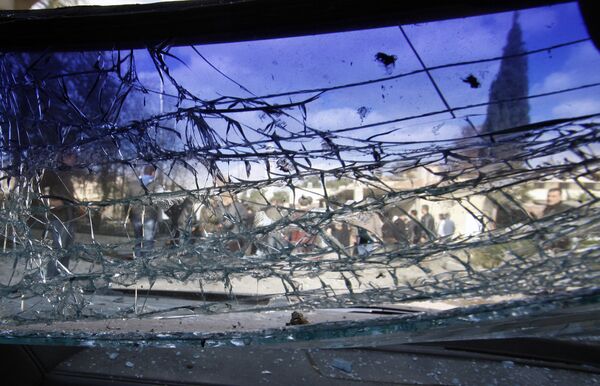
19/24
© AP Photo / Muzaffar Salman
Several terrorist groups, such as Daesh (also known as IS or ISIS) and Jabhat al-Nusra (also known as Jabhat Fatah al-Sham), fought alongside rebel armies against the forces of President Bashar Assad in the Syrian Civil War that ensued as a result of the popular unrest. The president questioned the existence of the "moderate opposition", arguing that his army opposes only terrorist groups "linked to the agendas of foreign countries". Some of these groups are still present in Idlib province and continuing their attacks against government forces and the local Russian contingency helping them.
Above: A cracked windshield is seen at the site of a suicide bombing in Damascus, Syria, Friday, 23 December 2011.
Above: A cracked windshield is seen at the site of a suicide bombing in Damascus, Syria, Friday, 23 December 2011.
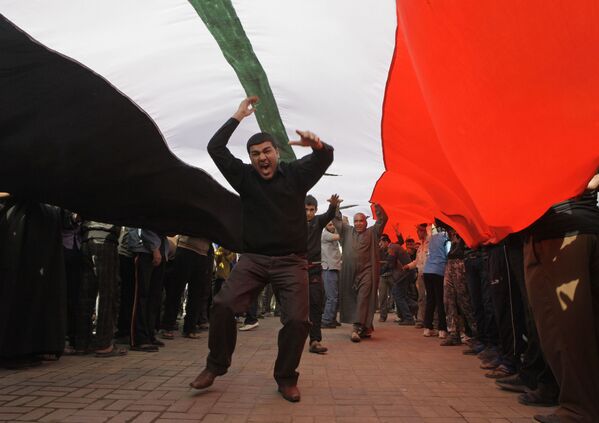
20/24
© AP Photo / Khalid Mohammed
Despite the attempts of Prime Minister Nouri al-Maliki to appease the public by not running again in 2014, protests still erupted in Iraq, with people demanding to investigate cases of alleged corruption in the federal government. They lasted for over 10 months in 2011 and often took place in Tahrir Square in Baghdad.
Above: Protesters chant anti-Iraqi government slogans under a huge Iraqi flag during a protest in Tahrir Square in Baghdad, Iraq, Wednesday, 23 February 2011.
Above: Protesters chant anti-Iraqi government slogans under a huge Iraqi flag during a protest in Tahrir Square in Baghdad, Iraq, Wednesday, 23 February 2011.
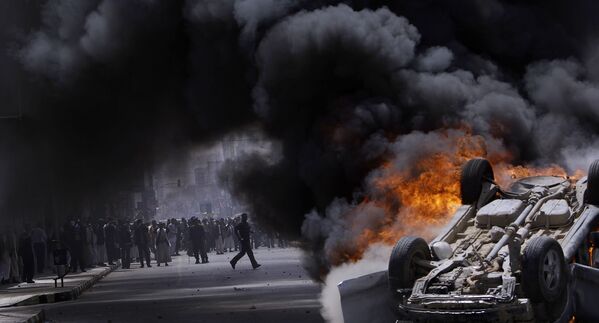
21/24
© AP Photo / Muhammed Muheisen
Like much of the unrest across the Arab world in 2011-2012, Yemeni citizens initially demanded changes to be made to their life – to combat unemployment, poor economic conditions, and corruption in the government. However, in the process, their demands grew to include the resignation of Yemeni President Ali Abdullah Saleh.
Above: Supporters of the Yemeni government seen through the smoke of a burning vehicle that was destroyed and set on fire by anti-government demonstrators during clashes in Sanaa, Yemen, Tuesday, 22 February 2011.
Above: Supporters of the Yemeni government seen through the smoke of a burning vehicle that was destroyed and set on fire by anti-government demonstrators during clashes in Sanaa, Yemen, Tuesday, 22 February 2011.
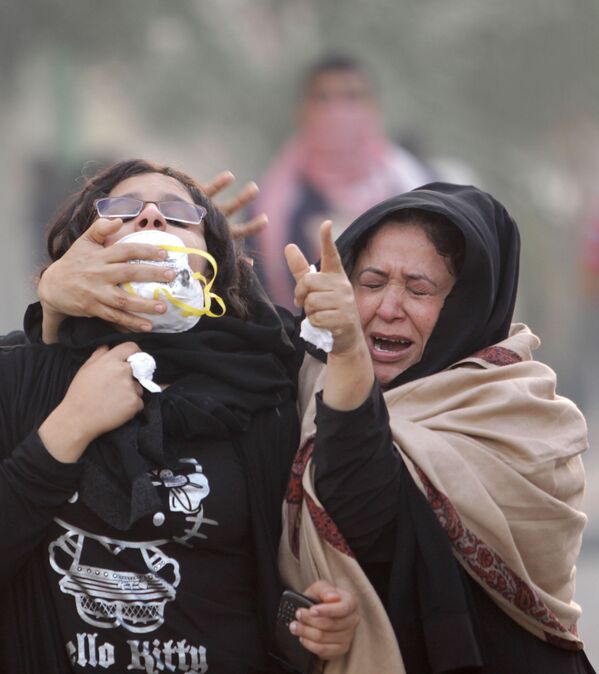
22/24
© AP Photo / Hasan Jamali
The protests in Bahrain were not as massive as in Egypt or Tunisia and lasted a little over a month in 2011 and emerged at an even smaller scale in 2012. The demonstrators ultimately failed to force King Hamad to step down.
Above: Anti-government protesters react to tear gas fired by riot police during clashes on Saturday, 17 December 2011, in Abu Saiba village west of the capital of Manama, Bahrain.
Above: Anti-government protesters react to tear gas fired by riot police during clashes on Saturday, 17 December 2011, in Abu Saiba village west of the capital of Manama, Bahrain.
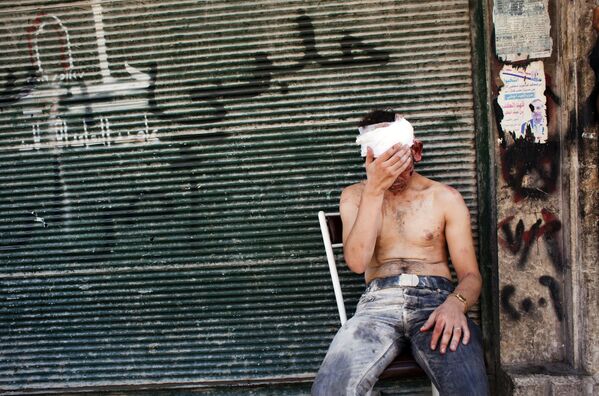
Damascus lost control over the city of Aleppo almost at the start of the unrest and subsequent civil war in 2012. It regained control over it, purging local rebels as well as the al-Nusra Front terrorist group from the city in December 2016 after a month-long offensive.
Above: In this file photo taken on 4 September 2012, a Syrian man wounded by shelling sits on a chair outside a closed shop in the Al-Muasalat area in Aleppo.
Above: In this file photo taken on 4 September 2012, a Syrian man wounded by shelling sits on a chair outside a closed shop in the Al-Muasalat area in Aleppo.
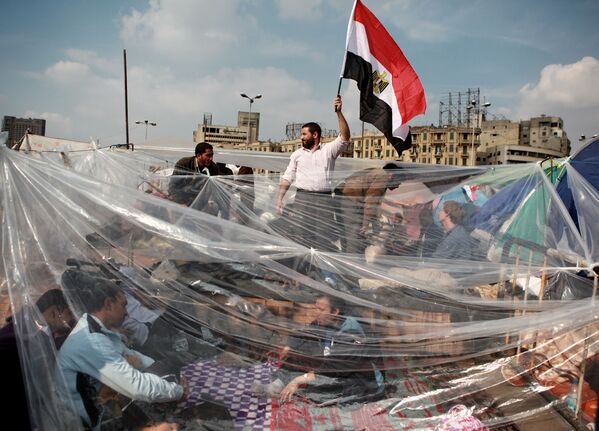
Cairo's Tahrir Square (translated as Liberation Square) became the main stage for protesters, who demanded the resignation of President Hosni Mubarak. Many of the demonstrations in the Egyptian cities were coordinated via social media platforms such as Facebook and Twitter, leading to the government's decision to shut down Internet access across the country in an unsuccessful attempt to thwart the protests.
Above: Protesters sit in a makeshift tent in Tahrir Square in Cairo.
Above: Protesters sit in a makeshift tent in Tahrir Square in Cairo.

